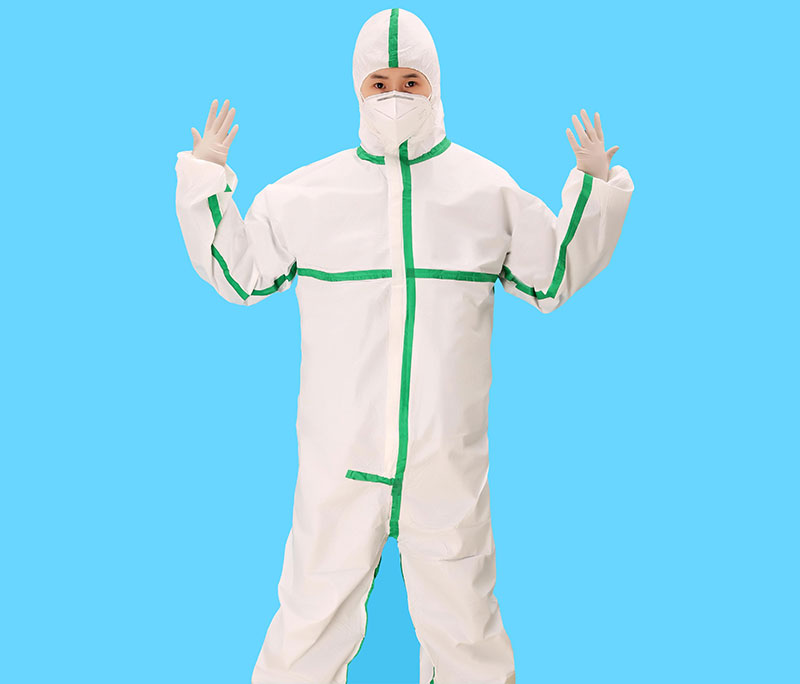Sales continue to grow, covering all over the world.
Classification and performance evaluation standard of medical protective clothing materials
Classification and performance evaluation standard of medical protective clothing materials

Medical protective clothing is one of the main types of protective clothing, which is often used in the link of medical industry that may be exposed to microorganisms, which can effectively resist the threat of external microorganisms and protect medical staff from harm. At present, there are different materials for medical protective clothing on the market, but no matter what materials are required to meet the requirements of various indicators, the specific contents are as follows.
Material type of medical protective clothing:
1. Coating material. Most domestic enterprises use wet or dry polyurethane, polyacrylate and polyvinylidene fluoride to coat the fabric, and then use this fabric to make protective clothing.
2. Pu and TPU membrane composites. Compared with the coating material, the moisture permeability and comfort of the composite are improved.
3. PTFE microporous membrane composite. The domestic military has a small batch of applications in the military uniforms of special services, but the application in medical protective clothing is still in the research and trial stage. Polytetrafluoroethylene microporous film can effectively solve the two shortcomings of coating material, PU, TPU membrane composite material poor durability and poor moisture permeability. The disadvantage of PTFE is high cost.
Standard for performance evaluation of medical protective clothing materials:
Medical protective clothing
1. Protection
The evaluation methods of protective performance mainly include hydrostatic pressure, water contact test, impact penetration, spray, blood permeation, microbial penetration and particle filtration efficiency.
GB 19082-2003 stipulates that the water contact level shall not be lower than Gb3, the hydrostatic pressure requires that 17cmh2o shall not penetrate, and synthetic blood shall not pass through protective clothing materials; en13795 stipulates that the standard performance and high performance of the low-risk area of the urban microbial penetration ≤ 2nlogo (CFU), and the high-risk area wet microbial permeability ≥ 2,8 / b. the surgical clothing and surgical hole towel are divided into standard performance and high performance, each performance It is divided into high-risk area and low-risk area. The requirements of hydrostatic pressure of surgical suit are ≥ 20cnh2o, ≥ 10cmh2o, ≥ 100cmh2o, ≥ 10cmh2o, respectively; the requirements of surgical hole towel are ≥ 30cmh2o, ≥ 10cmh2o, ≥ 10cmh2o; aamipb70 stipulates that the liquid permeability of grade I, grade 2 and grade 3 is ≤ 4.5g, ≤ 1.0g, ≤ 10g, and the hydrostatic pressure resistance values of grade 2 and grade 3 are ≥ 20cmh2o and ≥ 50cmh2o respectively For grade 4 surgical clothes, blood impermeability is required, and phage impermeability is required for surgical hole scarves: nfpa1999 requires that the finishing spray test is impermeable, and there is no phage penetration in virus penetration test, and the sputtering rate of splash test is ≥ 70%; the index requirements specified in YY / t0506 are consistent with en13795.
2. Comfort
As wearing materials, the comfort of protective clothing materials is affected by many factors, including air permeability, water vapor permeability, drapability, quality, surface thickness, electrostatic performance, color, reflectance, odor and skin sensitization, as well as the influence of design and sewing in garment processing. The main evaluation indexes are air permeability, moisture permeability, charge density, etc. According to nfpa1999, the overall heat dissipation is not less than 450W / M: gb19082 requires moisture permeability ≥ 2500g / M.D, and charging capacity ≤ 0.6 μ C; YY / t0506 requires that medical surgical clothing and surgical hole towel have air permeability.
3. Physical and mechanical properties
The evaluation methods of physical and mechanical properties of protective clothing materials mainly include breaking strength, bursting strength and puncture strength.
En13795 stipulates that the dry bursting strength is ≥ 40n, the wet bursting strength of high-risk area is ≥ 40n, the low-risk area is not required, the dry breaking strength is ≥ 20n, the wet breaking strength of high-risk area is ≥ 20n, and the low-risk area is not required; GB 19082 stipulates that the breaking strength is ≥ 45N, the elongation at break is ≥ 30%; nfpa1999 stipulates that the breaking strength of each layer is ≥ 135n, the bursting strength of each layer is ≥ 34kpa, and the puncture strength of each layer is ≥ 25N, tearing strength ≥ 36N, cracking strength ≥ 67N / 50mm.
In addition, GB 19082 also specifies the skin irritation, ethylene oxide residue, flame retardancy and disinfection resistance of medical protective clothing materials

| Contact person: Ms Jin | Foreign trade: Carol Qiu |
| Phone:+86 13938450051 | |
| Landline:+86 0371 67112186 | |
 hnjq2008@163.com hnjq2008@163.com | sales@hnjianqi.com |
 www.hnjianqi.com www.hnjianqi.com | www.jianqimedical.com |
Zone, Changyuan City, Henan |